What is a Resistor?
Previously, we learned what voltage is, how it can be made, and how it works in electronics. In this article, we will learn about the most fundamental component in electronics, the resistor!
What is Resistance?
 Before we can learn about resistors, we first need to understand what resistance is. Resistance is a material's ability to resist electrical flow and all materials have a measurable amount of resistance. Some materials, such as rubber and glass, have incredibly high resistances and are referred to as insulators. Materials such as copper and gold have very low resistances and are referred to as conductors. Some materials, however, have resistances in between conductors and insulators and are referred to as semi-conductors. Plumbing can be a very handy analogy to resistance with large pipes having low resistance while small pipes having large resistances.
Before we can learn about resistors, we first need to understand what resistance is. Resistance is a material's ability to resist electrical flow and all materials have a measurable amount of resistance. Some materials, such as rubber and glass, have incredibly high resistances and are referred to as insulators. Materials such as copper and gold have very low resistances and are referred to as conductors. Some materials, however, have resistances in between conductors and insulators and are referred to as semi-conductors. Plumbing can be a very handy analogy to resistance with large pipes having low resistance while small pipes having large resistances.
Resistance Specifics
 Resistance is measured in ohms and has the Ω symbol and was named after George Simon Ohm who discovered Ohms law. Ohms law states that the current through a conductor is inversely proportional to the resistance of the conductor for a fixed potential difference. Long story short, if resistance goes down then the current goes up and if the resistance goes up then the current goes down. 1Ω of resistance is defined as the resistance needed to produce a current of 1A with a potential difference of 1V.
Resistance is measured in ohms and has the Ω symbol and was named after George Simon Ohm who discovered Ohms law. Ohms law states that the current through a conductor is inversely proportional to the resistance of the conductor for a fixed potential difference. Long story short, if resistance goes down then the current goes up and if the resistance goes up then the current goes down. 1Ω of resistance is defined as the resistance needed to produce a current of 1A with a potential difference of 1V.
Resistance vs Resistivity
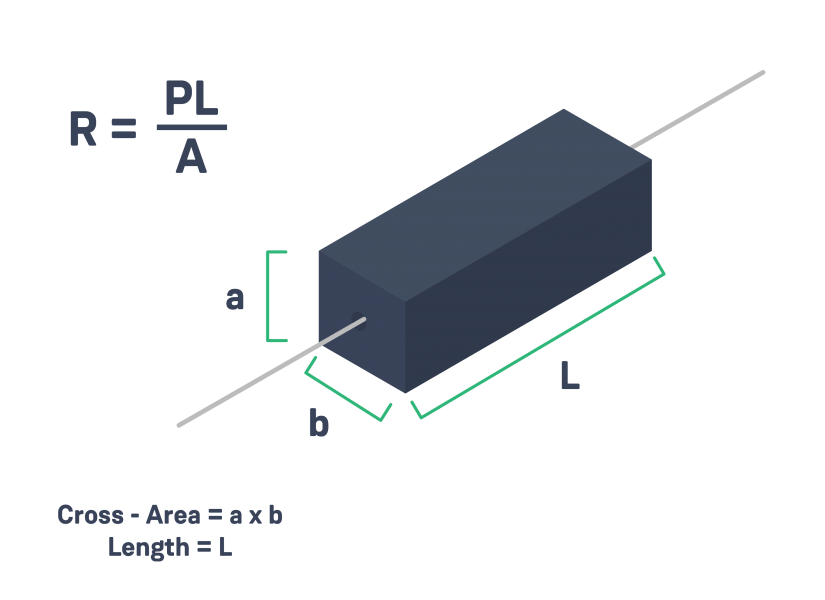 It is important to understand the difference between resistance and resistivity as while they are related, they refer to two different things. Resistance is the overall measured resistance of a material whereas the resistivity of a material is its resistance per unit length and cross-sectional area. This means that a wire made of copper may have a very low resistivity but can have a high resistance if made very long and very narrow. This also means that rubber, in theory, could be made very wide and very short and will have a low resistance. The symbol used for resistivity is ρ (rho) and has units Ω / m.
It is important to understand the difference between resistance and resistivity as while they are related, they refer to two different things. Resistance is the overall measured resistance of a material whereas the resistivity of a material is its resistance per unit length and cross-sectional area. This means that a wire made of copper may have a very low resistivity but can have a high resistance if made very long and very narrow. This also means that rubber, in theory, could be made very wide and very short and will have a low resistance. The symbol used for resistivity is ρ (rho) and has units Ω / m.
What is a Resistor
 Now that we have learned about resistance and resistivity it’s time to learn about resistors! Resistors are components in electronics that add resistance to a circuit and are arguably the most fundamental component. While all components (including wires) in a circuit have resistance, resistors are put in place to intentionally add resistance but can also be used to make adjustments to amplifier outputs, set configuration bits, and control the output voltage of a regulator. In electronic schematics resistors can have either one of two symbols depending on if you are following the American standard or the international standard. American schematics use squiggly lines which come from a time when resistors used to be made from thin strands of wire wrapped around a body. International schematics use the rectangular box and is the more commonly used symbol. Which one you use is up to you but it is best to keep to the international standard as it is used by more countries.
Now that we have learned about resistance and resistivity it’s time to learn about resistors! Resistors are components in electronics that add resistance to a circuit and are arguably the most fundamental component. While all components (including wires) in a circuit have resistance, resistors are put in place to intentionally add resistance but can also be used to make adjustments to amplifier outputs, set configuration bits, and control the output voltage of a regulator. In electronic schematics resistors can have either one of two symbols depending on if you are following the American standard or the international standard. American schematics use squiggly lines which come from a time when resistors used to be made from thin strands of wire wrapped around a body. International schematics use the rectangular box and is the more commonly used symbol. Which one you use is up to you but it is best to keep to the international standard as it is used by more countries.
There are two main types of resistors that exist; fixed and variable. Fixed resistors are those whose resistance does not change while variable resistors can adjust their resistance. The two symbols shown above are for fixed resistors only while variable resistors all have different symbols depending their type.
Types of Resistors - Through-hole vs. SMD vs. Trimmer Resistors vs. Potentiometers vs. LDRs vs.
There are several different types of resistors. Through-hole resistors, Surface Mount Device (SMD) resistors, trimmer resistors, potentiometers, Light Dependent Resistors (LDRs), and thermistors all exist. Each accomplishes generally the same task of applying resistance, but in different ways. Learn all about the various resistor varieties!
Different types of resistors:
- Through-hole
- Trimmer resistors
- Surface Mount Device or SMD
- Light Dependent Resistors (LDRs)
- Thermistors
- Potentiometers
What are Through-hole Resistors?
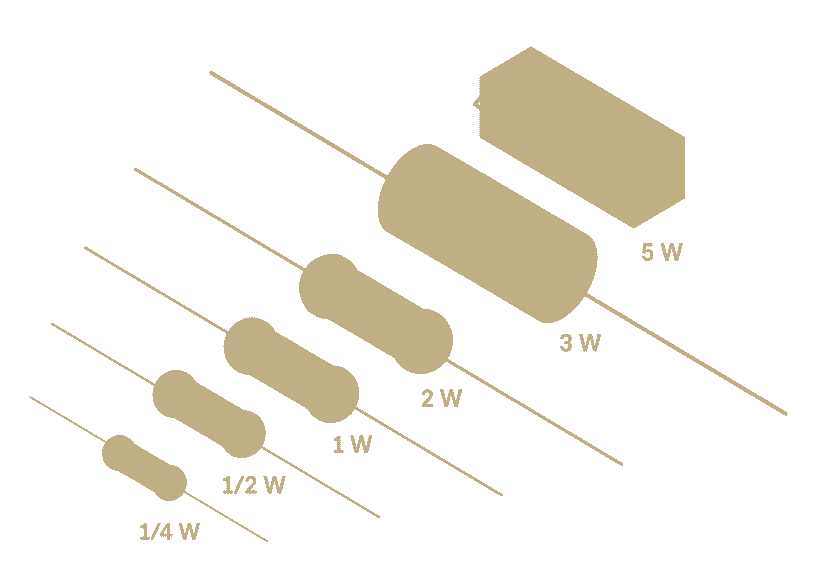 Through-hole resistors are those that have legs that fit through holes in a PCB and then soldered down. These resistors come in a wide variety of types depending on their application with carbon-film being the most common and metal-film being used in applications requiring accuracy. Carbon-film and metal-film resistors use color bands to indicate their resistance with four-band resistors being the most common. Through-hole resistors also come in different power ratings with the 1/4W being the most popular with makers but larger powers are available. Very large power resistors are often made with ceramic materials and include mounting holes but are not often seen in electronics.
Through-hole resistors are those that have legs that fit through holes in a PCB and then soldered down. These resistors come in a wide variety of types depending on their application with carbon-film being the most common and metal-film being used in applications requiring accuracy. Carbon-film and metal-film resistors use color bands to indicate their resistance with four-band resistors being the most common. Through-hole resistors also come in different power ratings with the 1/4W being the most popular with makers but larger powers are available. Very large power resistors are often made with ceramic materials and include mounting holes but are not often seen in electronics.
What are SMD Resistors?
 SMD resistors are those that are housed in Surface Mount Device (SMD) packages and are mostly found in modern commercial products. While makers can use SMD components they are often harder to use due to their very small size. These resistors, however, are significantly cheaper as well as easier to use in automated processes (such as pick and place machines), hence their popularity in the commercial field. Just like through-hole resistors, SMD resistors come in a wide variety of shapes and sizes depending on their power dissipation and application. Most of these resistors use printed numbers on their body to indicate their resistance but more recent SMD resistors are now so small that numbers can’t even be printed on them.
SMD resistors are those that are housed in Surface Mount Device (SMD) packages and are mostly found in modern commercial products. While makers can use SMD components they are often harder to use due to their very small size. These resistors, however, are significantly cheaper as well as easier to use in automated processes (such as pick and place machines), hence their popularity in the commercial field. Just like through-hole resistors, SMD resistors come in a wide variety of shapes and sizes depending on their power dissipation and application. Most of these resistors use printed numbers on their body to indicate their resistance but more recent SMD resistors are now so small that numbers can’t even be printed on them.
What are Trimmer Resistors?
 Trimmer resistors are variable resistors that allow a designer to make precision adjustments to a circuit. These types of resistor can either be in a through-hole or SMD package and generally have their overall resistance value printed on them. Trimmers generally require multiple full turns on their input to make small changes to their resistance and this is helpful in applications that require careful control of the resistance of a circuit such as those found in amplifiers.
Trimmer resistors are variable resistors that allow a designer to make precision adjustments to a circuit. These types of resistor can either be in a through-hole or SMD package and generally have their overall resistance value printed on them. Trimmers generally require multiple full turns on their input to make small changes to their resistance and this is helpful in applications that require careful control of the resistance of a circuit such as those found in amplifiers.
What are Potentiometers?
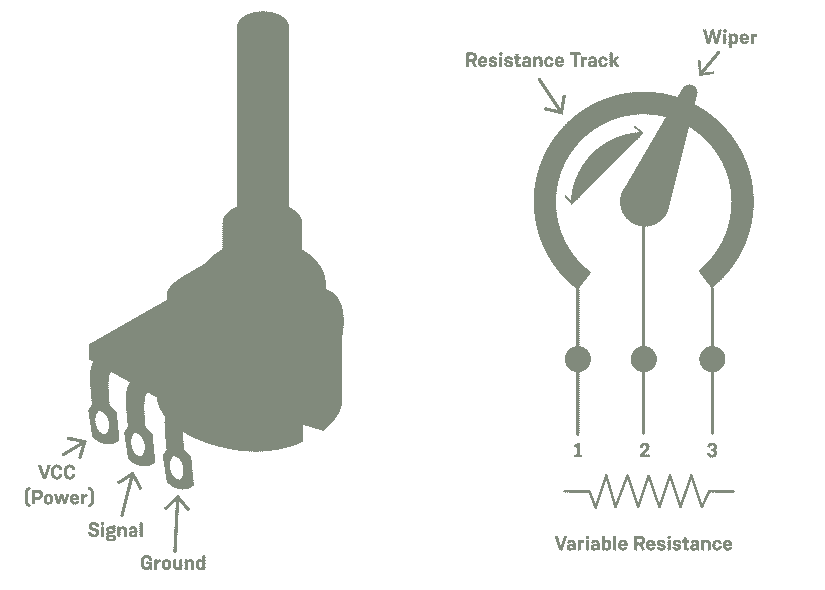 Potentiometers are variable resistors that have three pins that allow for either an adjustable resistance (using two legs) or for an adjustable voltage (using all three legs). Unlike trimmer resistors, potentiometers are often used for basic controls where precision is not required but control is. Potentiometers generally don’t allow for more than a full turn with a common example being volume dials. They have two limits, min and max, and adjustment between these two points adjusts the volume. While SMD potentiometers do exist, they are often found in through-hole packages as they require mechanical stability when used.
Potentiometers are variable resistors that have three pins that allow for either an adjustable resistance (using two legs) or for an adjustable voltage (using all three legs). Unlike trimmer resistors, potentiometers are often used for basic controls where precision is not required but control is. Potentiometers generally don’t allow for more than a full turn with a common example being volume dials. They have two limits, min and max, and adjustment between these two points adjusts the volume. While SMD potentiometers do exist, they are often found in through-hole packages as they require mechanical stability when used.
What are LDRs or Light Dependent Resistors?
 Light Dependent Resistors, or LDRs, are resistors whose resistance is dependent on the light that falls on them. These resistors are available in both SMD and through-hole parts with the through-hole variety being more common. However, these devices are made using Cadmium-Sulphide which is a toxic substance and banned under RoHS which is why these devices are quickly disappearing. If a light sensitive circuit is required then it is better to use a photodiode.
Light Dependent Resistors, or LDRs, are resistors whose resistance is dependent on the light that falls on them. These resistors are available in both SMD and through-hole parts with the through-hole variety being more common. However, these devices are made using Cadmium-Sulphide which is a toxic substance and banned under RoHS which is why these devices are quickly disappearing. If a light sensitive circuit is required then it is better to use a photodiode.
What are Thermistors?
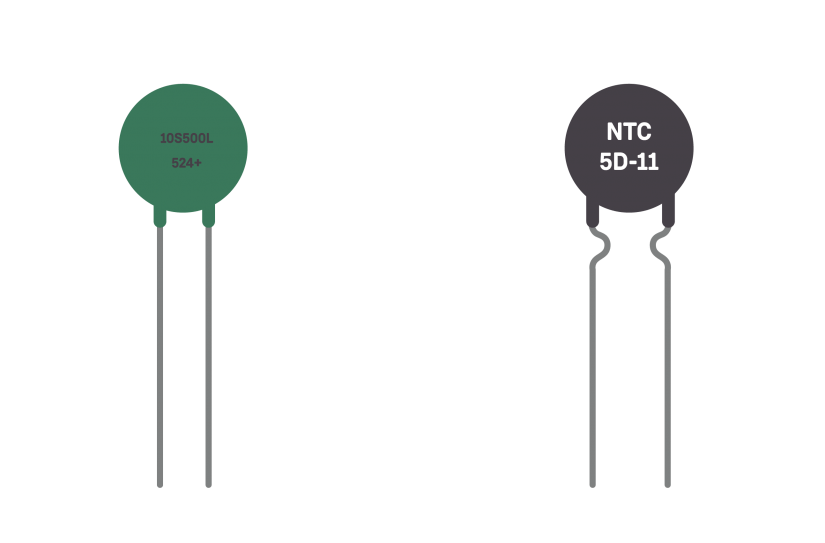 Thermistors are variable resistors whose resistance depends on their temperature and are available in both through-hole and SMD varieties. Of these categories, two more exist which indicate how the resistance of the thermistor changes with temperature; Positive Temperature Coefficient (PTC) or Negative Temperature Coefficient (NTC). PTC thermistors are those whose resistance increases with temperature while the resistance of an NTC thermistor goes down when the temperature increases.
Thermistors are variable resistors whose resistance depends on their temperature and are available in both through-hole and SMD varieties. Of these categories, two more exist which indicate how the resistance of the thermistor changes with temperature; Positive Temperature Coefficient (PTC) or Negative Temperature Coefficient (NTC). PTC thermistors are those whose resistance increases with temperature while the resistance of an NTC thermistor goes down when the temperature increases.
Resistor Arrangements
When using resistors in circuits it is important to know the two equations that tell you the total resistance of a circuit depending on their configuration. In short, resistors in series add up while resistors in parallel subtract (but in a very complex way).
For resistors in series
 For resistors in parallel
For resistors in parallel
 1/RTotal =1/R1 +1/R2 +⋯1/Rn
1/RTotal =1/R1 +1/R2 +⋯1/Rn
Resistor Color Codes
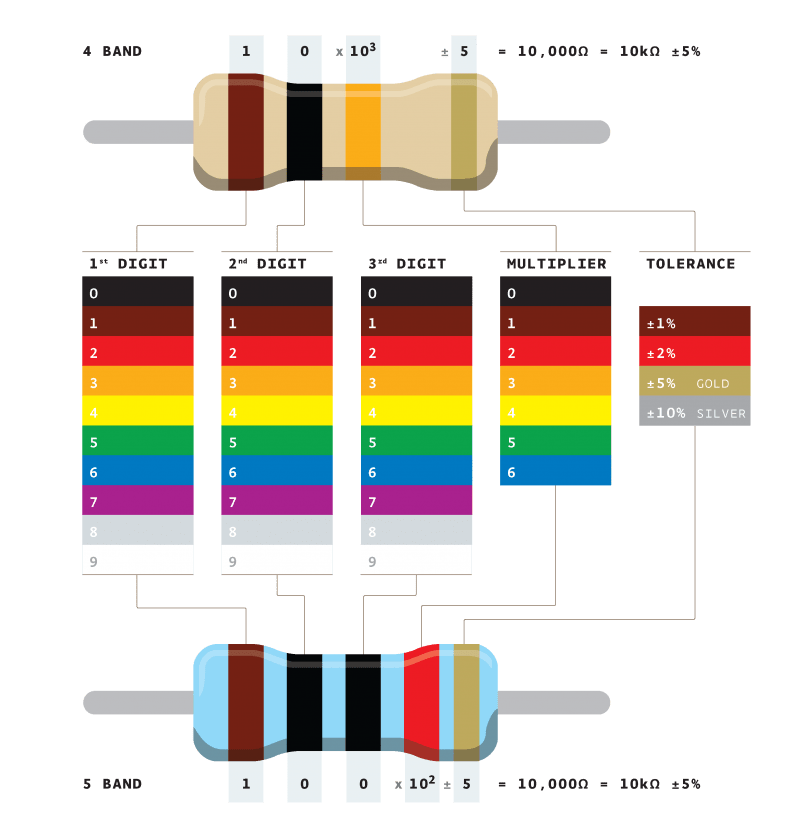 Most standard resistors feature color codes to help you calculate the resistive value of a resistor. Typically, you'll find resistance value, wattage rating, and tolerance stamped on a resistor. For smaller resistors, this is specified by color bands. Resistor color codes therefore indicate the total resistive value of a particular resistor. There are three-, four-, five-, and six-band resistors. With a three-band resistor, the first two bands show the resistance value, while the third band is the multiplier. WIth a four-band resistor, the first two bands give resistance values followed a multiplier, then a gap between the third and fourth bands indicating the direction by which to read, and the fourth band tells its tolerance. A five-band resistor gives resistance with the first three bands, the multiplier with its fourth, and tolerance with the fifth. A six-band resistor indicates resistance with its first three bands, multiplier with the fourth, tolerance with its fifth, and fail rate for the sixth.
Most standard resistors feature color codes to help you calculate the resistive value of a resistor. Typically, you'll find resistance value, wattage rating, and tolerance stamped on a resistor. For smaller resistors, this is specified by color bands. Resistor color codes therefore indicate the total resistive value of a particular resistor. There are three-, four-, five-, and six-band resistors. With a three-band resistor, the first two bands show the resistance value, while the third band is the multiplier. WIth a four-band resistor, the first two bands give resistance values followed a multiplier, then a gap between the third and fourth bands indicating the direction by which to read, and the fourth band tells its tolerance. A five-band resistor gives resistance with the first three bands, the multiplier with its fourth, and tolerance with the fifth. A six-band resistor indicates resistance with its first three bands, multiplier with the fourth, tolerance with its fifth, and fail rate for the sixth.
Common Real-world Uses of Resistors
So how are resistors used in the real-world? They're pretty common components. Often times, you'll find resistors utilized for gain control, heat generation, dividing voltage and controlling voltage fluctuations in conjunction with a capacitor, power absorption in RF transmitters, and other applications.
Real-world uses of resistors:
- LEDs - resistors in series limit current and lower voltage
- Gain control in amps
- Controlling voltage fluctuations alongside a capacitor (i.e. traffic lights)
What is a Resistor and What is Resistance - Final Thoughts
Resistors are critical in modern electronics being able to limit current, control voltages, and provide configuration to circuits. Understanding how to use them, what they look like, and what types are available will not only help you with future projects but better make use of components. Maybe your next project needs a temperature sensor or is required to be very small; now you can go out and start exploring the world of resistance for yourself!





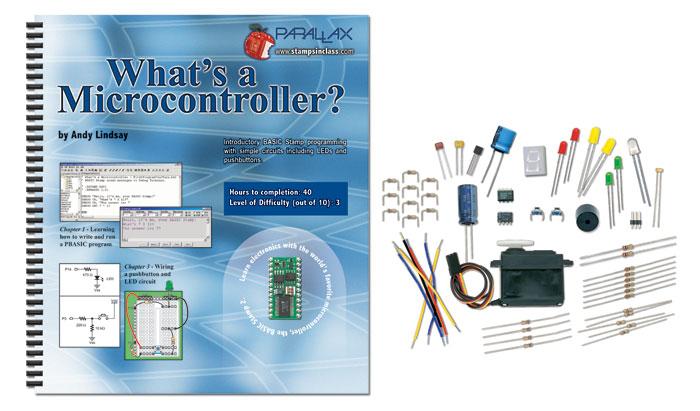


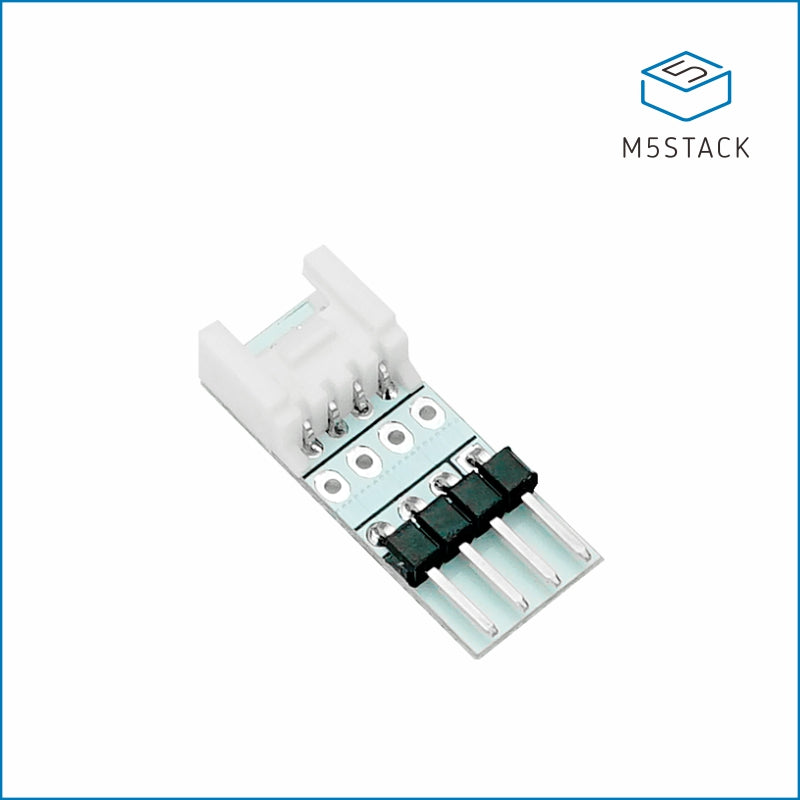
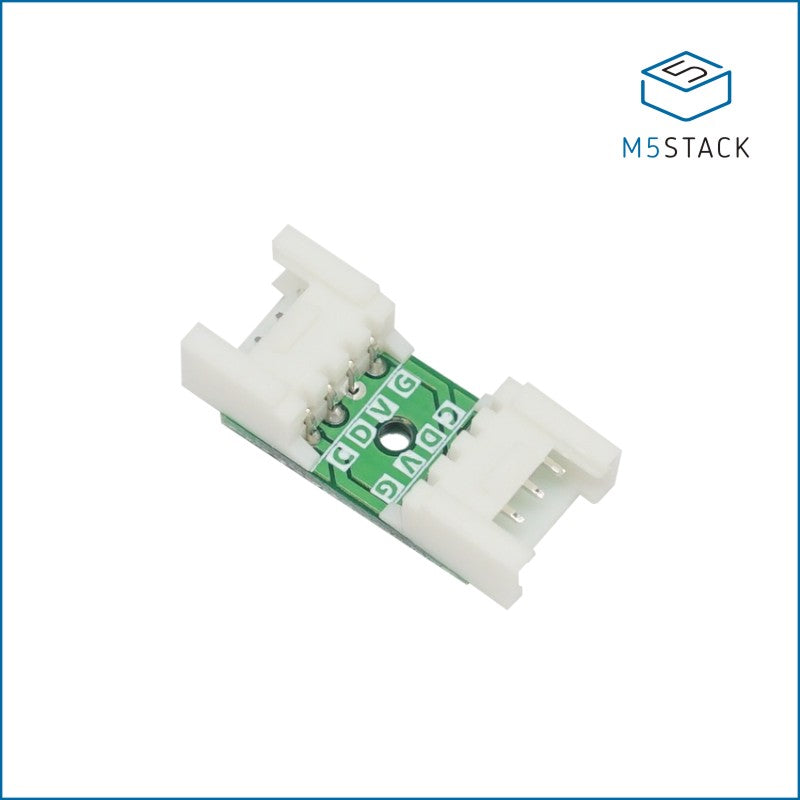
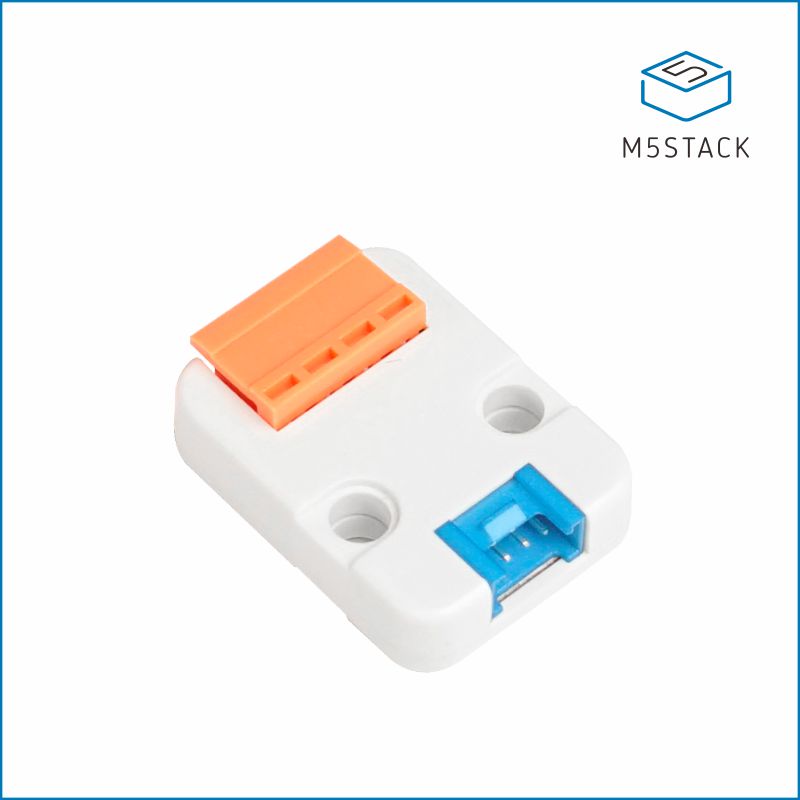
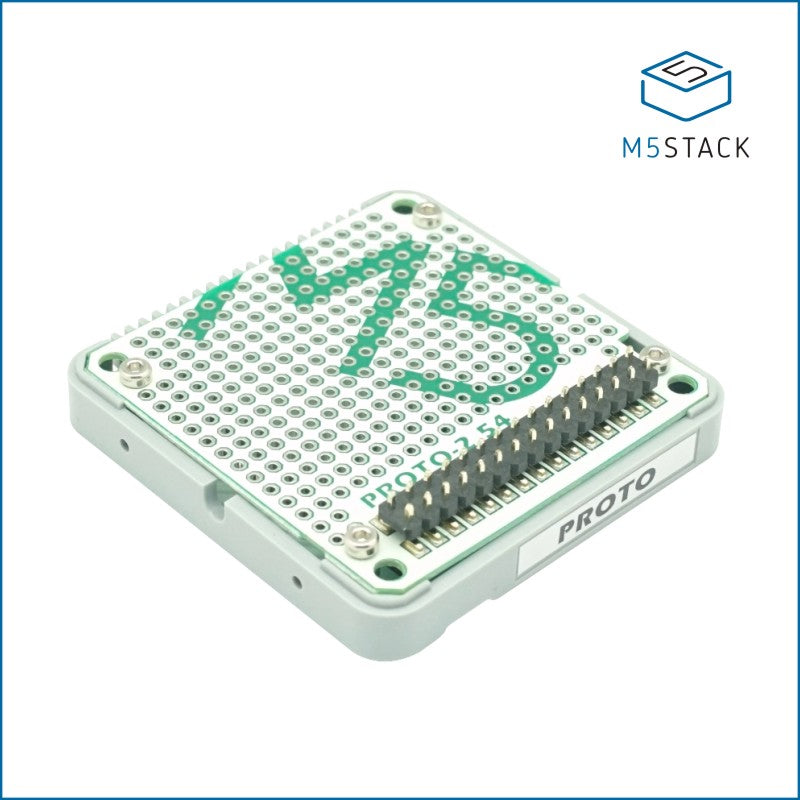
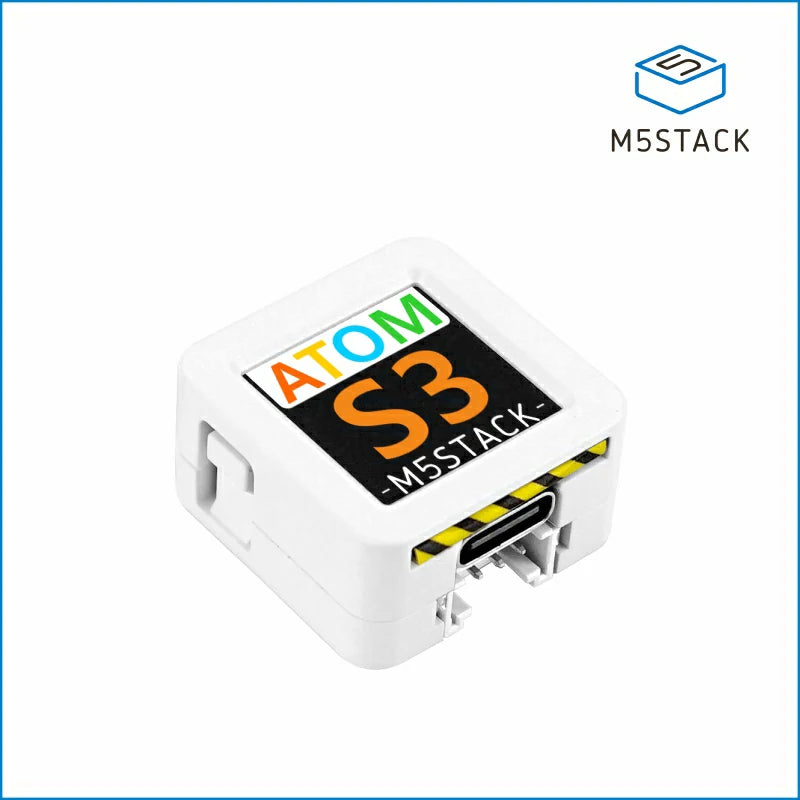
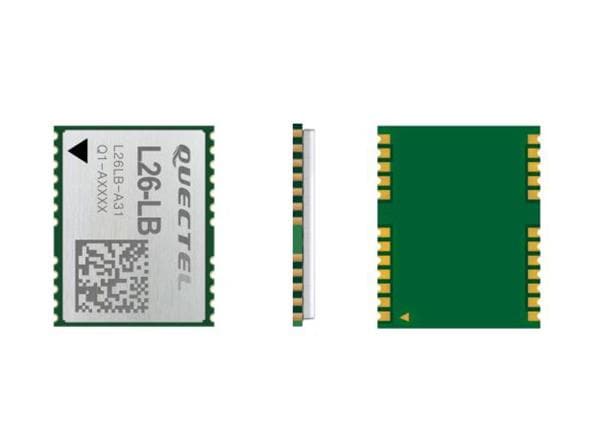
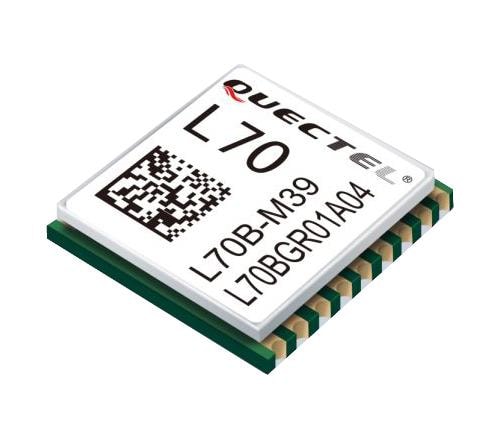
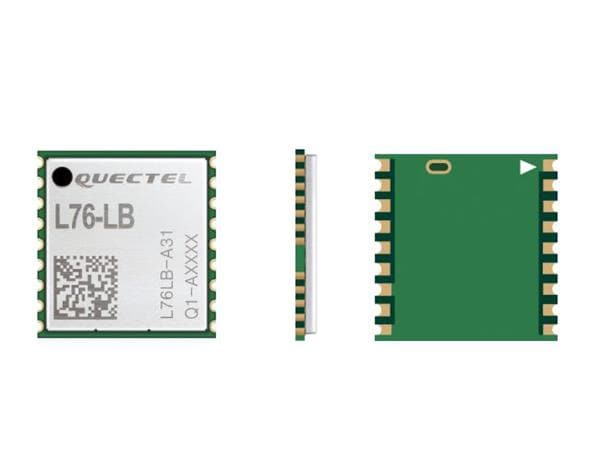
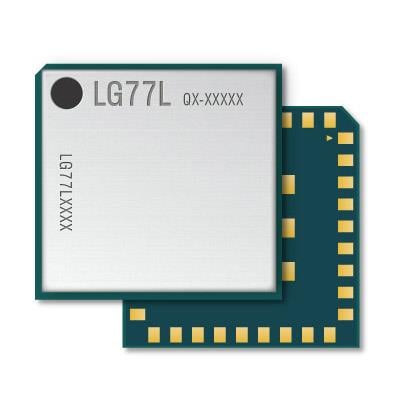
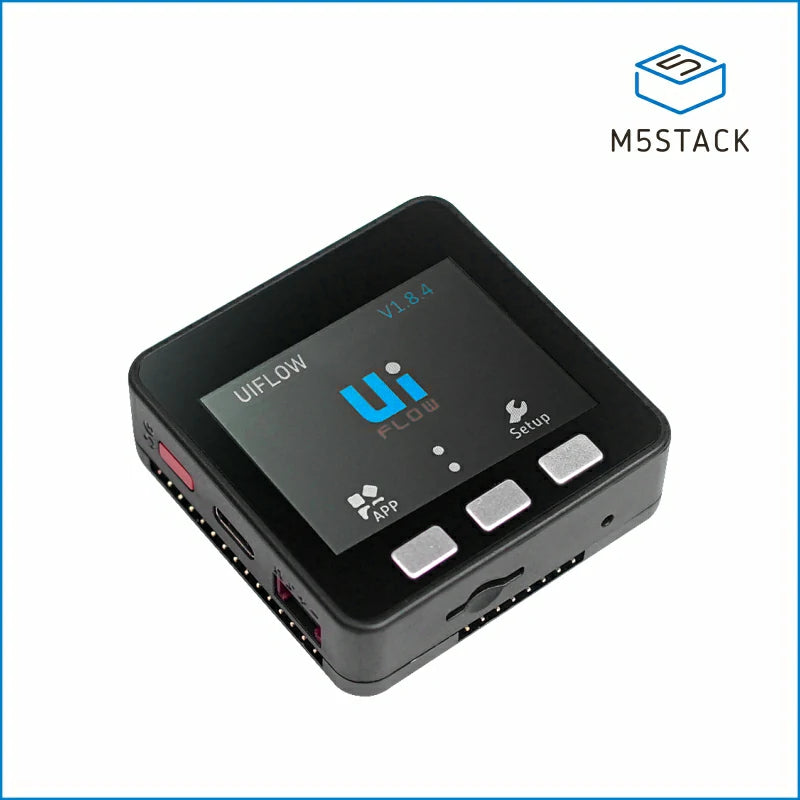
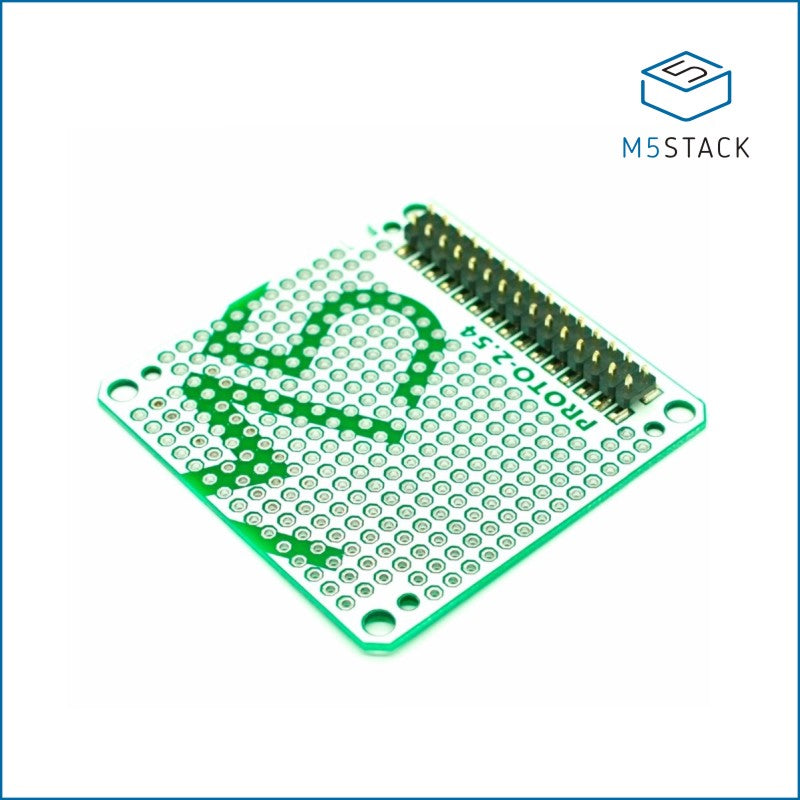









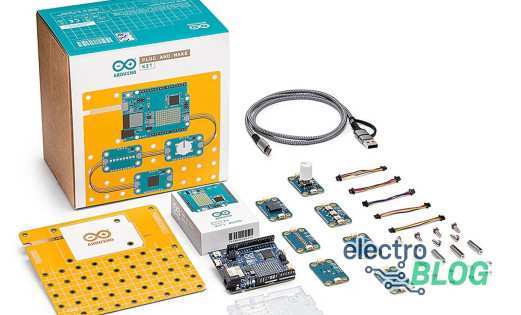






Leave your feedback...